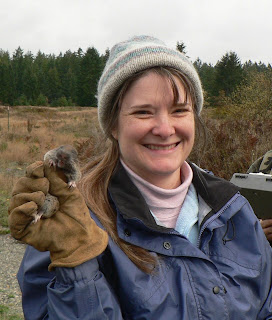It began with a tadpole.
 |
| (Photo: Jim Rorabaugh/USFWS) |
So, one of my older siblings was forced to reluctantly take me to the nearest tadpole-bearing puddle about a block from our house. I’d take my Dixie cup with me, and my brother or sister would help me carefully scoop up one or more tadpoles into my little cup of pond water. We’d walk back home, and before my nap, I’d briefly hold those wiggling tadpoles in my little palm, loving the way they felt when they moved in cool, silky motions on my cupped hand, gazing in awed wonder at how their wet skin reflected the light. To my three-year-old eyes, they were beautiful.
 |
| Kim holding a Mazama Pocket Gopher (Photo credit: Linda Saunders-Ogg) |
That captivation persisted into my young adulthood and still holds me in thrall today. It extends to plants, insects, birds, and mammals of all shapes and sizes. Every new thing I learn about a species is fascinating to me: the ways they've adapted to their environments, the ways they're perfectly - or imperfectly - formed for the day-to-day tasks they undertake, how they communicate with each other, how they eat and grow.
It’s all amazing and inspiring.
I believe that each and every species deserves to be respected, exclaimed over, and conserved for our grandchildren’s grandchildren. This is why I work on listing and recovery. The position allows me to help achieve Service conservation goals, while also assisting the general public. Conservation work benefits agriculture, ecotourism, education, science, health, recreation, ecosystems, and biodiversity. That's a lot of benefits!
I'm also more than amply rewarded when I interact with the next generation of conservationists. The round-eyed faces of elementary school kids often light up when I teach them how to hoot like an owl or explain how an albatross can lock its wings in place, coasting effortlessly over the world’s wide oceans for days, weeks, months, or years at a time. Knowing that other people will get to experience the wonder of the natural world and all its furry, scaly, feathery, growing critters and plants pleases me to no end.
 |
| Kim teaching students about habitat conservation (Photo credit: USFWS) |
No comments:
Post a Comment
Note: Only a member of this blog may post a comment.